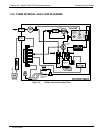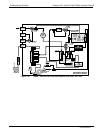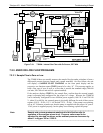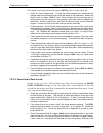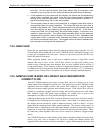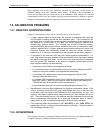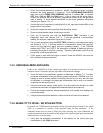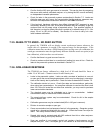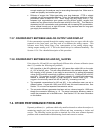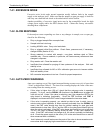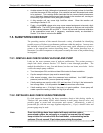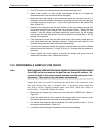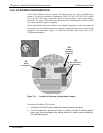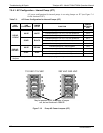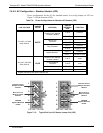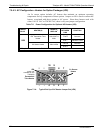
Teledyne API - Model T200H/T200M Operation Manual Troubleshooting & Repair
237
enough sample gas, the analyzer may be evacuating the sample line. Make sure to
create and properly vent excess span gas.
Diffusion of oxygen into Teflon-type tubing over long distances. PTFE or related
materials can act as permeation devices. In fact, the permeable membrane of NO
2
permeation tubes is made of PTFE. When using very long supply lines (> 1 m)
between high concentrations span gases and the dilution system, oxygen from
ambient air can diffuse into the line and react with NO to form NO
2
. This reaction is
dependent on NO concentration and accelerates with increasing NO concentration,
hence, affects linearity only at high NO levels. Using stainless steel for long span
gas supply lines avoids this problem.
7.3.7. DISCREPANCY BETWEEN ANALOG OUTPUT AND DISPLAY
If the concentration reported through the analog outputs does not agree with the value
reported on the front panel, you may need to re-calibrate the analog outputs. This
becomes more likely when using a low concentration or low analog output range.
Analog outputs running at 0.1 V full scale should always be calibrated manually. See
Section 4.13.6.2 for a detailed description of this procedure.
7.3.8. DISCREPANCY BETWEEN NO AND NO
X
SLOPES
If the slopes for NO and NO
X
are significantly different after software calibration (more
than 1%), consider the following two problems
NO
2
impurities in the NO calibration gas. NO gases often exhibit NO
2
on the order
of 1-2% of the NO value. This will cause differences in the calibration slopes. If the
NO
2
impurity in NO is known, it can easily be accounted for by setting the expected
values for NO and NO
2
accordingly to different values, e.g., 0.448 ppm NO and 0.45
ppm NO
X
. This problem is worse if NO gas is stored in a cylinder with balance air
instead of balance gas nitrogen or large amounts of nitrous oxide (N
2
O). The
oxygen in the air slowly reacts with NO to yield NO
2
, increasing over time.
The expected concentrations for NO and NO
X
in the calibration menu are set to
different values. If a gas with 100% pure NO is used, this would cause a bias. See
Section 7.2 on how to set expected concentration values.
The converter efficiency parameter has been set to a value not equal to 1.000 even
though the conversion efficiency is 1.0. The actual conversion efficiency needs to
match the parameter set in the CAL menu. See Section 5.2.5 for more information
on this feature.
7.4. OTHER PERFORMANCE PROBLEMS
Dynamic problems (i.e. problems which only manifest themselves when the analyzer is
monitoring sample gas) can be the most difficult and time consuming to isolate and
resolve. The following section provides an itemized list of the most common dynamic
problems with recommended troubleshooting checks and corrective actions.
07270B DCN6512



